NDVI stands for "Normalized Difference Vegetation Index". NRG stands for "Near-infrared / Red / Green". NDVI and NRG are both ways to visualize the amounts of infrared and other wavelengths of light reflected from vegetation. Because both these methods compare ratios of blue and red light absorbed versus green and IR light reflected, they can be used to evaluate the health of vegetation. It's a snapshot of how much photosynthesis is happening. This is helpful in assessing vegetative health or stress. (Read more here: https://www.agronomy.org/publications/jeq/articles/36/3/832) ## Do-It-Yourself These techniques for vegetation analysis were developed for satellite imagery, but at Public Lab, we've been working a lot on capturing infrared imagery using our DIY [near-infrared camera](/wiki/near-infrared-camera) setup, and combining it with visible bands to produce NDVI images such as the one above. ## What these images mean What exactly are these images we're trying to make? What do they tell us about vegetation, and why? These diagrams should help to understand what it is we're doing and why these are good ways to analyze plant life. ## The NDVI equation [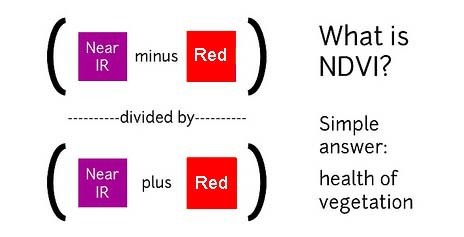](/i/44723) **NDVI = (Near Infrared - Red)/(Near Infrared + Red)** NDVI is a ratio which tries to emphasize photosynthesis while filtering out sun glare. The above equation is run for every pixel, using source data from an infrared photo and a visible light photo, like this pair: [](https://publiclab.org/system/images/photos/000/021/771/original/5390895115_c9d4d38fec_o.jpg) The result can be false-colored to make the high-photosynthesis areas more clear, and used to examine where plants are and how healthy they are. [](https://publiclab.org/system/images/photos/000/021/770/original/PetVISNDVIcomp.png) _Figure above: Normal color photo (right) and normalized difference vegetation index (NDVI) image (left). NDVI image was derived from two color channels in a single photo taken with a camera modified with a special infrared filter. Note that tree trunks, brown grass, and rocks have very low NDVI values because they are not photosynthetic. Healthy plants typically have NDVI values between 0.1 and 0.9. -- @cfastie_ ### Activities Here are a range of activities you can do to produce and interpret your own NDVI imagery, whether downloaded from a satellite imagery provider or [collected yourself using a DIY technique](/wiki/multispectral-imaging) [activities:ndvi] ****   Most DIY converted cameras today (those from Public Lab) use RGN instead of NRG, so the blue channel represents infrared instead of the red channel. That looks like this: [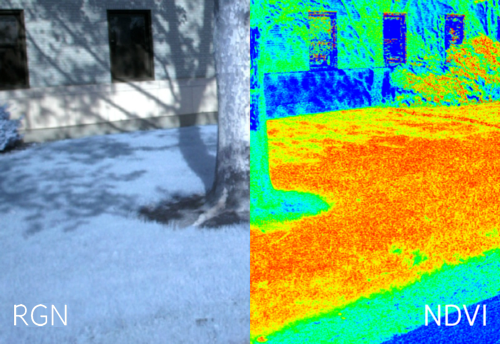](/i/45468?s=o) **** ## NRG imagery Some people are also interested in producing NRG imagery (like the below image), where `Near-Infrared, Red, and Green` are used to compose a picture instead of the usual `Red, Green, and Blue`. [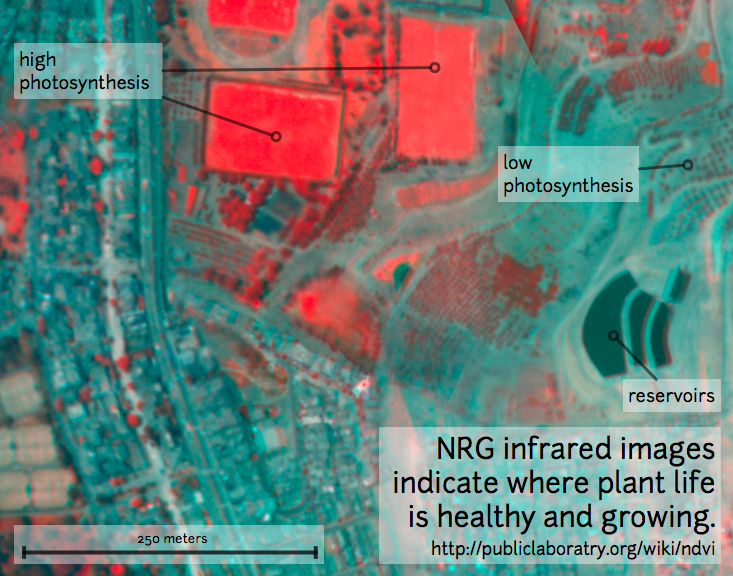](/i/25064) This diagram explains the swapping, which allows us to 'see' infrared as if it were a normal color: [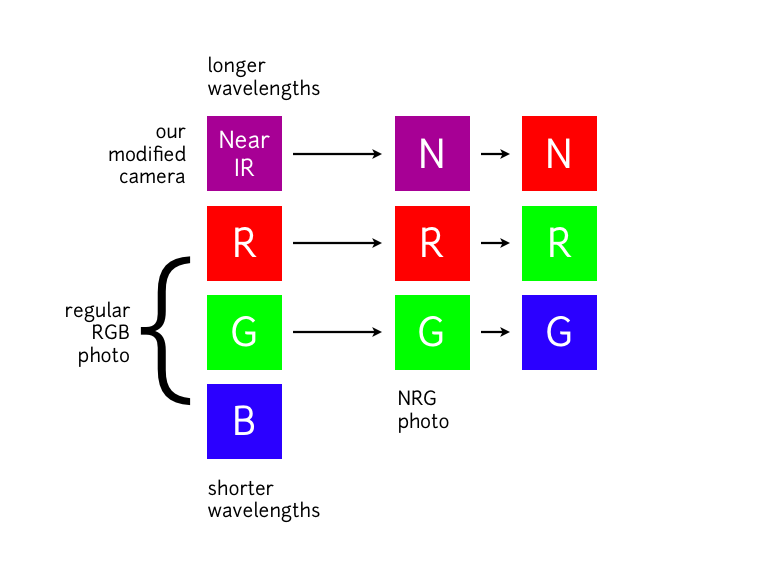](/i/25063) **In NRG images, the deeper and clearer the red color, the denser and healthier the vegetation (more or less).** ### Questions [questions:ndvi] ### Other examples of DIY NDVI imaging From around the internet: Begin watching at 2 minutes to see the resulting imagery: *This topic is part of the [Grassroots Mapping Curriculum](/wiki/mapping-curriculum) series.* **** [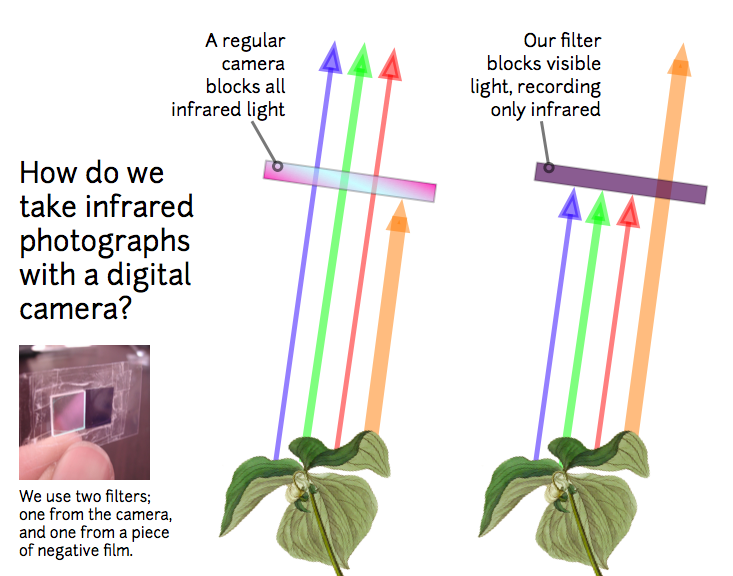](/i/25066) [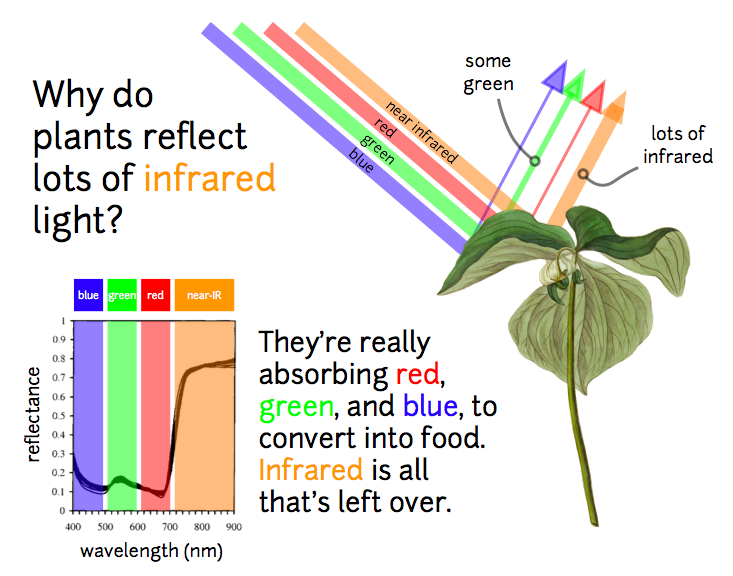](/i/25065) ...
| Author | Comment | Last activity | Moderation | ||
|---|---|---|---|---|---|
| khadedipak | "This is one of the best blog for articles and poems on various topics. stay tune for further updates. CLICK HERE " | Read more » | over 4 years ago | |||
| warren | "Hi, can you share the images you do get, before and after your calibration? " | Read more » | over 4 years ago | |||
| warren | "Hi, you can use this simpler sequence for that: https://sequencer.publiclab.org/examples/#steps=ndvi,colormap This will just apply NDVI and the c..." | Read more » | over 4 years ago | |||
| starstalenthunt | "Star Talent Hunt : Find your Dream Job Now and Get a chance to become famous in entertainment industry. " | Read more » | over 4 years ago | |||
| ThomasTaufan | "Chris, please look at my image taken from modified camera using red filter bought from Public Lab. Is this the correct results or should I do some ..." | Read more » | over 4 years ago | |||
| ThomasTaufan | "how to process single multispectral image with the modified webcam and red filter? Because when I saw your example, it is processing 2 images that ..." | Read more » | over 4 years ago | |||
| ramprasadraju1998 | "Model Papers 2020 " | Read more » | over 4 years ago | |||
| ramprasadraju1998 | "This is one of the best blog for free Model papers 2020 About AP 10th 12th intermodelPapers, WHich can be very helpful fro your Daily life. Stay in..." | Read more » | over 4 years ago | |||
| Bronwen | "I don't own a drone myself, but I do see lots of camera lenses marketed for different drone camera models (I've used some of these for our microsco..." | Read more » | over 4 years ago | |||
| Bronwen | "We do have some information already tagged with drone/ndvi " | Read more » | over 4 years ago | |||
| zomb23 | "Hi Chris, thank you for the quick and comprehensive response. That sounds really promising. I will look into chlorophyll fluorescence and if/how I ..." | Read more » | over 4 years ago | |||
| cfastie | "I think NDVI will provide some information about the photosynthetic rate of mosses. Moss leaves capable of rapid photosynthesis will probably be ab..." | Read more » | over 4 years ago | |||
| cfastie | "`>>So according to this we should be getting about 10% transmission of red light, does that mean I should subtract 10% of each pixel value in..." | Read more » | almost 5 years ago | |||
| nstarli | "Thanks for the detailed response Chris, this is super helpful! I really appreciate the feedback. So I have actually been provided the full charact..." | Read more » | almost 5 years ago | |||
| cfastie | "I don't know for sure whether your protocol with the RPi camera (use automatic white balance with blue paper) and my protocol with a Powershot (use..." | Read more » | almost 5 years ago | |||
| nstarli | "Thanks for the reply Chris. I have read through pretty much every single one of your posts! So my white balance calibration is the simple one that ..." | Read more » | almost 5 years ago | |||
| cfastie | "I am not familiar with your white balance procedure so I don't know how it is affecting your results. If you can manually set the white balance, se..." | Read more » | almost 5 years ago | |||
| nstarli | "Sorry, I meant to include the cfastie colormap image as well: " | Read more » | almost 5 years ago | |||
| nstarli | "Where can I find the blue calibration card? I could not find it on the public lab store. " | Read more » | almost 5 years ago | |||
| warren | "and! https://publiclab.org/infragram-pi " | Read more » | almost 5 years ago | |||
| warren | "Just noting that our Infragram Pi Cam kits now ship with onboard software and WiFi: https://store.publiclab.org/collections/diy-infrared-photograp..." | Read more » | almost 5 years ago | |||
| petter_mansson1 | "I just took some colored pieces of paper I found at the office. The paper squares was only added to show other people that I didnt just re color th..." | Read more » | almost 5 years ago | |||
| nstarli | "Where did you get the calibration objects shown in the picture? Do you know the exact spectral properties of the colored squares and that is how yo..." | Read more » | almost 5 years ago | |||
| nickyshen0306 | "Thanks for giving me so many solutions!! I will try it. " | Read more » | almost 5 years ago |